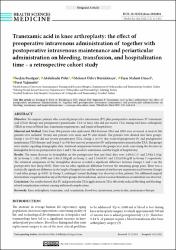| dc.contributor.author | Dinçel, Yaşar Mahsut | |
| dc.contributor.author | Başılgan, Seçkin | |
| dc.contributor.author | Polat, Abdulkadir | |
| dc.contributor.author | Özbey Büyükkuşçu, Mehmet | |
| dc.contributor.author | Yağmurlu, Mehmet Fırat | |
| dc.date.accessioned | 2023-05-06T17:22:11Z | |
| dc.date.available | 2023-05-06T17:22:11Z | |
| dc.date.issued | 2022 | |
| dc.identifier.issn | 2636-8579 | |
| dc.identifier.uri | https://doi.org/10.32322/jhsm.1024881 | |
| dc.identifier.uri | https://search.trdizin.gov.tr/yayin/detay/1156346 | |
| dc.identifier.uri | https://hdl.handle.net/20.500.11776/12104 | |
| dc.description.abstract | Objective: To compare patients who received preoperative intravenous (IV) plus postoperative maintenance IV tranexamic acid (TXA) therapy and perioperative periarticular TXA to those who did not receive TXA during total knee arthroplasty (TKA) in terms of blood loss, transfusion requirements, and length of hospital stay. Material and Method: Data from 194 patients who underwent TKA between 2016 and 2019 were reviewed. A total of 106 patients were included. Twenty-one patients were male, and 95 were female. The patients were divided into three groups: Group 1 (n=37) that did not receive perioperative TXA, Group 2 (n=35) that received preoperative IV and postoperative maintenance TXA therapy, and Group 3 (n=34) that received preoperative IV and perioperative periarticular TXA. The groups were similar regarding demographic data. Statistical comparisons between the groups were made concerning the decrease in hemoglobin levels on postoperative days 1 and 3, the need for transfusion, and the length of hospital stay. Results: The mean decrease in hemoglobin on the postoperative first and third days were 1.69(±1.13) and 2.94(±1.14)g/ dl, in Group 1, 1.41(±0.99) and 2.44(±1.28)g/dl, in Group 2, and 1.24(±0.83) and 2.21(±0.84)g/dl in Group 3 respectively. The statistical comparison of the hemoglobin decrease revealed a significant difference between Groups 1 and 3 on the postoperative first day(p<0.05). There was no other significant difference between the remaining group pairs. There was a statistically significant difference in the length of hospital stay and the amount of erythrocyte suspension used between Groups 1 and other groups (p<0.05). In Group 1, prolonged wound discharge was observed in four patients. No additional surgical intervention was performed in any of the three groups due to infection, and no vascular thrombosis or embolism was observed. Conclusion: Our results showed that IV and periarticular TXA applications in TKA effectively reduced bleeding and bleeding- related complications without causing additional complications. | en_US |
| dc.language.iso | eng | en_US |
| dc.identifier.doi | 10.32322/jhsm.1024881 | |
| dc.rights | info:eu-repo/semantics/openAccess | en_US |
| dc.subject | Knee arthroplasty | en_US |
| dc.subject | tranexamic acid | en_US |
| dc.subject | transfusion | en_US |
| dc.subject | blood loss | en_US |
| dc.subject | intravenous | en_US |
| dc.subject | periarticular | en_US |
| dc.subject | maintenance therapy | en_US |
| dc.title | Tranexamic acid in knee arthroplasty: the effect of preoperative intravenous administration of together with postoperative intravenous maintenance and periarticular administration on bleeding, transfusion, and hospitalization time – a retrospective cohort study | en_US |
| dc.type | article | en_US |
| dc.relation.ispartof | Journal of health sciences and medicine (Online) | en_US |
| dc.department | Fakülteler, Tıp Fakültesi, Cerrahi Tıp Bilimleri Bölümü, Ortopedi ve Travmatoloji Ana Bilim Dalı | en_US |
| dc.identifier.volume | 5 | en_US |
| dc.identifier.issue | 2 | en_US |
| dc.identifier.startpage | 614 | en_US |
| dc.identifier.endpage | 618 | en_US |
| dc.institutionauthor | Dinçel, Yaşar Mahsut | |
| dc.relation.publicationcategory | Makale - Ulusal Hakemli Dergi - Kurum Öğretim Elemanı | en_US |
| dc.identifier.trdizinid | 1156346 | en_US |



















